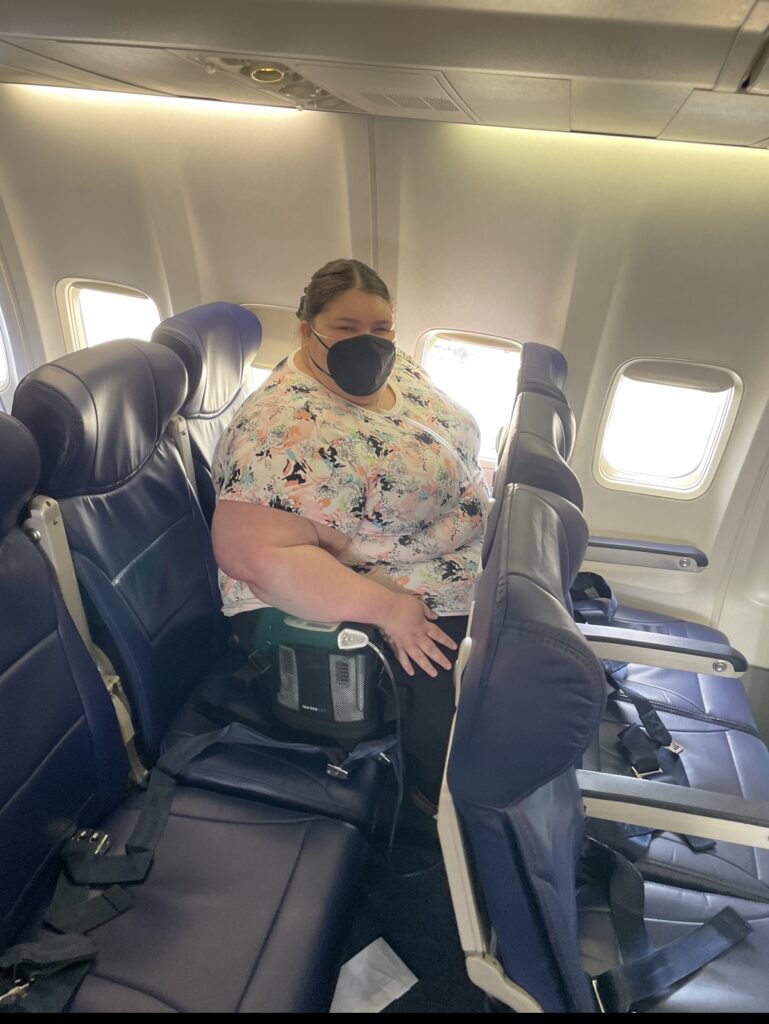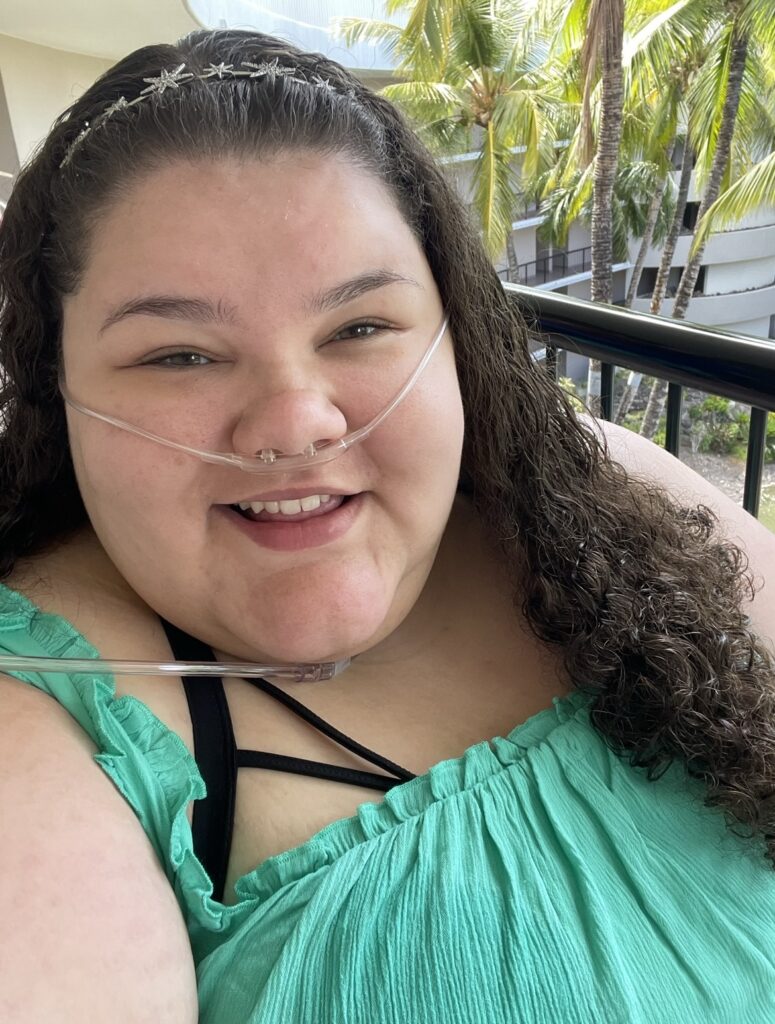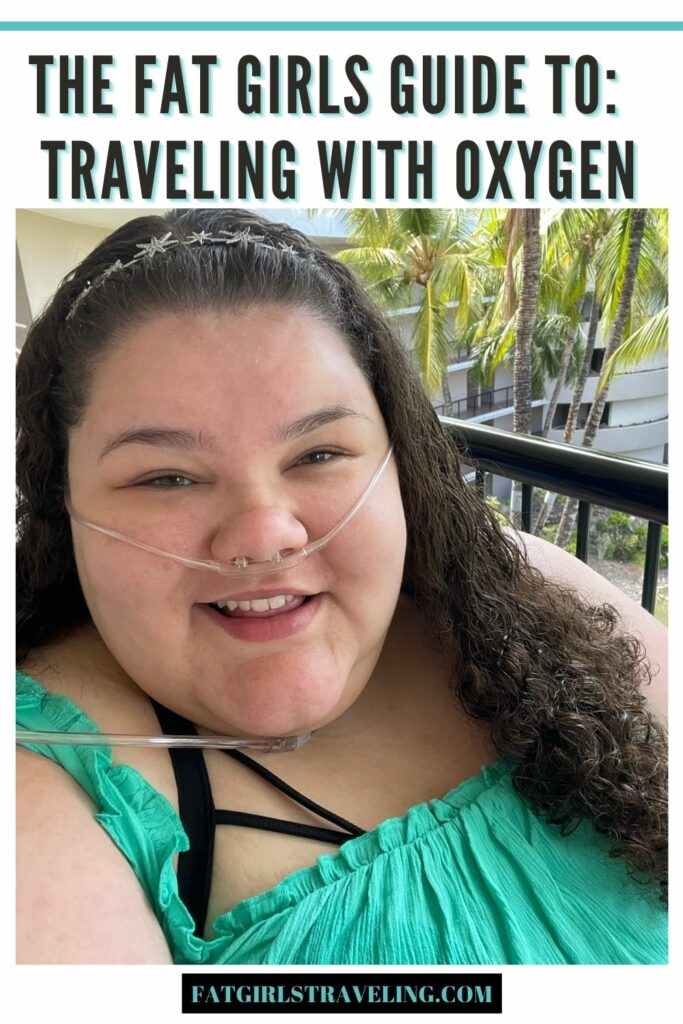Have you ever used a portable oxygen device while traveling? I have! People are often surprised to hear that you can take your portable oxygen device on a plane with you. As a Plus-Size Travel Blogger and Disability Advocate, I get asked many questions about traveling with oxygen. In 2019 I was diagnosed with a rare lung disease called Pulmonary Hypertension which is why I use supplemental oxygen.
People use supplemental oxygen for all types of reasons and whatever the case may be I hope these questions help encourage you to travel if that’s what you dream of. I’m excited to share my experiences traveling with a portable oxygen device and answer some of the frequently asked questions I receive from other travelers.
What types of Portable Oxygen Devices are there?
There are 3 types of portable oxygen devices: Compressed Gas Systems (cylinders/tanks), Portable Oxygen Concentrators (POCs), and Liquid Oxygen Systems.
When I was first put on supplemental oxygen, I was given a large at-home oxygen concentrator and a set of small oxygen tanks to be used outside of the home. Before you can travel with oxygen you will need to be given some type of portable oxygen device, either an oxygen cylinder (tank) or portable oxygen concentrator (POC). The type of travel you are doing will determine what type of portable oxygen device is best for you. For short outings or road trips, oxygen tanks might just do the trick, while air travel requires a portable oxygen concentrator.
I have the most experience with Oxygen tanks and POCs as those are the devices I’ve used while traveling. While there are 3 different types of Portable Oxygen devices, only Portable Oxygen Concentrators are allowed to be used on aircraft. I find that Portable Oxygen Concentrators give me the most freedom when traveling. When I first got a POC I felt like the world had opened back up to me and I could travel whenever I wanted without feeling limited.
What if I don’t own a Portable Oxygen Concentrator?
This is a great question! If you currently only have access to an at-home concentrator or oxygen tanks and need a Portable Oxygen Concentrator there are a few options. The first thing you need to do is contact your doctor and request a prescription for a Portable Oxygen Concentrator. From that point you can start the process of getting a POC from your oxygen supplier through your insurance, however, this process can take up to several months.
If your trip is quickly approaching and you don’t want to wait, there are two other options. You can take the prescription and purchase your own POC, these devices range anywhere from $1,495 – $3,945. If purchasing your own Portable Oxygen Concentrator isn’t a viable option for you, then you can rent a Portable Oxygen Concentrator through your oxygen supplier or through an online oxygen supply company such as Liberty Medical, whom I’ve had great experiences with. The cost to rent a Portable Oxygen Concentrator will depend on the type of machine you’re renting, the duration of your trip, and how many additional batteries you need if any.
Do airlines require you to do anything before you can travel with oxygen?
Yes, airlines do require you to complete a few steps before flying. The first thing you’ll need to do is determine the airline you’re going to be flying with and look into their specific policies surrounding traveling with oxygen. This will give you an idea of whether or not they will require you to have a doctor’s note and how much notice they require before your flight. Once you’ve determined this information you can begin booking your flights. Some airlines will allow you to notify them that you’ll be using a POC when booking your tickets. When booking your seats please keep in mind that you cannot sit in an exit row seat if you’re traveling with a POC.

Oftentimes it’s recommended that you see your doctor before traveling with oxygen. Getting a signed letter from your doctor stating your medical need for oxygen and the type/amount of oxygen flow you need can be required for some types of travel. Some airlines will require that the letter include your doctor’s contact information, a statement about your condition, written approval for the specific type of travel, confirmation you require oxygen, and the flow rate/duration of use.
The next step you need to take is to check and make sure the Portable Oxygen Concentrator you’re going to be using is approved by the Federal Aviation Administration (FAA approved). To do this you can go to either the airlines’ website or the Transportation Security Administration’s (TSA) website and check to see which POCs are on their approved list. If your POC isn’t directly listed, look for a red message on your POC or give the airline a call and tell them the model of your POC and they will tell you if it’s approved. If the POC you have is not approved by the FAA, then you will need to rent or buy a POC that is FAA approved before your flight.
The next step is a very important one, the Department of Transportation (DOT) requires that anyone using a POC on board a flight must have 150% of their total flight time in battery life. This means that you must bring enough batteries with you to power your POC for 150% of the flight time whether the airplane has power outlets or not. So if your flight time is 8 hours, you will need to have enough batteries to last you 12 hours total. If you don’t own enough batteries to last you 150% of the flight time, you must rent or purchase additional batteries before your flight. This can change depending on the airline so always refer to the airline’s website to ensure you have the most accurate information.
The next step in this process is to notify the airline that you’ll be flying with oxygen at least 48 hours ahead of time (check the airline’s policy for an exact amount of time) if you haven’t already. At this time, you will also want to make sure that you’ve submitted any documentation or required forms from the airline. Make sure to bring copies of any forms that you submitted or filled out along with any documentation from your doctor with you to the airport.
What happens when I get to the airport with my Portable Oxygen Concentrator?
Ok so you’ve submitted all your forms, charged all your batteries beforehand, and you’ve just arrived at the airport (with plenty of time to spare), this is what happens next…
You’ll head to the ticket counter and get checked in, they will ask you for your POC information and will check that it’s FAA approved. Then you’ll head to security where they will either ask you to remove your oxygen if possible to inspect it or if that’s not possible they will have you bypass the screening machines and will give you a TSA pat-down. They will swab your machine to inspect it and make sure that it’s good to go.
Once you’re done at security you will head to your gate where the gate agent will check to make sure you have enough batteries to last 150% of the flight time. They might ask you to demonstrate your understanding of how your machine works or how you would respond in case an alarm on the machine went off. This is why it comes in handy to have the Users Manual available with you in case you need to look over it. To give you peace of mind you can also double-check that you’re not seated in an exit row seat once you get to the ticket counter.
How do I travel with oxygen when going to an international destination?
While I’ve personally never traveled internationally with a Portable Oxygen Concentrator I have done tons of research to answer this question for all of you. When it comes to traveling internationally most of the same rules apply, the main differences to take into consideration are lengthier flight times, power adapters/outlets, your POCs capabilities, and the oxygen policies of the international airlines’.
If you’re flying abroad the chances are that you’re going to be in the air much longer than a flight within the continental United States. Therefore, you’re going to need more batteries than normal. You will want to make sure that you rent or purchase the correct amount of batteries for your trip abroad. Take into consideration that you will be using your device much more than when you’re at home and therefore will need to charge it more frequently. Investing in an external battery charger might be well worth it if you’re going to be on the go quite a bit.
When it comes to purchasing the right power adapter, doing your research is an absolute must! Different countries have outlets that might look very similar to the ones here in the United States, but use a different voltage which if not used properly could damage your POC. You can find universal adapters that might do the trick like this one. To figure out your POCs power specifications you can check your User Manual or find the User Manual online for your specific concentrator. In some countries, the electrical output is vastly different and could result in your device taking longer to charge or not receiving enough power to charge. That’s why investing in an external battery charger could be a real game-changer for those looking to travel overseas.
Another thing to take into consideration when traveling with a POC, especially internationally, is your concentrator’s capabilities. When deciding on destinations you want to travel to it’s very important to consider the altitude and temperature. Some POCs simply can’t function properly when pushed outside certain parameters. For example, my Zen-O by GCE Healthcare has a maximum operating altitude of 13,000 feet. Therefore if I’m at a destination where the altitude is higher than that, my concentrator won’t be able to adequately supply enough oxygen. When it comes to temperature, my POC can only operate in conditions between 41°F to 104°F. So again, if I’m in a location where the temperatures are outside this range, my concentrator won’t function properly. You can find your POCs technical information within the User Manual or on the manufacturer’s website.
Just like in the United States where different airlines have different policies, the same can be said for airlines in other countries. While your POC might be approved here in the U.S for air travel, it might not be for certain international airlines. So when you’re choosing which international airline you’re going to be flying on you’ll want to double-check that your POC is going to be accepted. You’ll want to check and see what the rules and regulations are for using a POC in the country or countries you’ll be traveling to. Some might require that you carry your prescription with you at all times, while some might not allow your POC aboard an aircraft. These are all things you will want to look up before you decide which destination(s) you’ll be traveling to.
Will the increased altitude affect my oxygen needs?
While it is possible that the increased altitude in some locations can affect your oxygen needs, it isn’t always the case. Upon doing research it’s been stated that “Commercial airlines must provide a cabin pressure of no more than 8,000 feet of altitude.” Most POCs can function up to 10,000 feet which is well within the range of cabin pressure. As I stated above, it’s highly recommended to see your doctor before you fly on a plane especially if it’s your first time flying with oxygen. I find that seeing your doctor before a flight can give you some peace of mind. If you are worried about the increased altitude affecting your oxygen needs you can ask your doctor to order an altitude simulation test. I always bring a pulse oximeter with me when I fly with my oxygen concentrator to track my oxygen levels if I feel the need to.
Does my Portable Oxygen Device count as one of my allowed carry-on items?
No! The great thing is that medical devices don’t count towards your baggage allowance. This means that you can still have a carry-on and one personal item aboard the plane as usual. However, keep in mind that your Portable Oxygen Concentrator must fit beneath the seat in front of you. In general, any other approved medical or assistive devices that you need can be checked as an item for free.
Can I charge my Portable Oxygen Device on the plane?
Unfortunately, even on aircraft that have outlets, the outlet will most likely not be able to supply enough power to charge your POC. This is one of the reasons that the DOT requires you to have enough batteries to last 150% of the flight time. Some airlines don’t have outlets on their aircraft either, so it’s best not to rely on being able to charge your POC in flight. I highly recommend that you charge your POC battery and extra batteries the night before your flight. I also recommend that you keep your POC plugged in whenever you’re able to access an outlet at the airport before boarding and during layovers.
What should I keep in mind once I get to my destination?
Once you get to your destination you will want to be sure you are charging your POC regularly. Depending on how active you plan on being during your trip, prioritizing battery life will be crucial to enjoying your stay. Make sure to bring your charger with you anytime you leave for long periods. I would highly recommend bringing a car charger with you so that you can charge your POC while on the road. Bringing a carrying case for your POC will also help you keep it safe and allow you the freedom to explore.

Always check the weather before you go on outings for the day and bring something to help keep your POC safe and dry. If you’re going to be around water be sure to store your POC in a safe location where it won’t get wet. Be sure to keep track of the temperature as well and store your POC in the shade if it’s going to be a really hot day. Your POC is essentially your lifeline while you’re away and you want to make sure it’s going to function at its best for the duration of your travels.
Is travel possible without a Portable Oxygen Concentrator?
Yes, travel is possible without a POC, however, it is a bit more limited than travel with a POC. If you don’t have a POC you can still travel by car, train, or boat but air travel requires a POC. When traveling with oxygen tanks you can check with your oxygen supplier to see if they can re-supply you with oxygen tanks at key locations you’ll be traveling to.
If you’re going on a road trip you can always consider bringing your at-home concentrator with you to use once you arrive at your destination(s). I have done this many times and have never encountered any issues. Bringing your at-home machine with you will allow you to use fewer oxygen tanks. If you’re traveling by car be sure to never leave your tanks in a hot car as it can be unsafe.
If you’re traveling by boat or train you will want to look up the company policies surrounding traveling with oxygen. Overall, travel is possible without a Portable Oxygen Concentrator, but it will involve a few additional steps.
Here are some additional tips for traveling with oxygen:
- When you are packing your bags make sure to bring all the charging cables you can think of for your POC, extra nasal cannulas, the user manual, and anything else you might need.
- When you get to the airport make it a habit to charge your batteries anytime you’re near an outlet so that you’ll have plenty of battery life to spare.
- Try to get to the airport at least two hours early so that you have plenty of time to get situated.
- When traveling with oxygen it’s a good rule of thumb to get to your gate with at least an hour to spare.
- Make sure to store your extra batteries in your carry-on along with any other medically necessary items you might need on the plane.
- Bring a pulse oximeter with you in your carry-on so you can check your oxygen levels while on the plane.
- Renting a POC is a great idea if you’re worried about putting additional wear and tear on your personal POC.
One of the best pieces of advice I can give you when you’re traveling with oxygen is to plan ahead as much as possible. Traveling with oxygen might look different and it might require a bit of additional effort, but it is well worth it! Your need for supplemental oxygen doesn’t have to hold you back from traveling! I hope this answered some of the questions you have about traveling with oxygen. Remember people of all sizes and abilities deserve to travel the world just as much as anyone else. All bodies can be travel bodies and that includes you!





